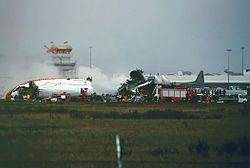This article needs additional citations for verification .(May 2008) |
 Wreckage of the aircraft at Faro Airport | |
| Accident | |
|---|---|
| Date | 21 December 1992 |
| Summary | Crashed on hard landing due to windshear and foggy weather |
| Site | Faro Airport, Faro, Portugal 37°00′46″N7°57′53″W / 37.01278°N 7.96472°W |
 | |
| Aircraft | |
 PH-MBN, the aircraft involved in the accident, seen in 1991 | |
| Aircraft type | McDonnell Douglas DC-10-30CF |
| Aircraft name | Anthony Ruys |
| Operator | Martinair |
| IATA flight No. | MP495 |
| ICAO flight No. | MPH495 |
| Call sign | MARTINAIR 495 |
| Registration | PH-MBN |
| Flight origin | Amsterdam Schiphol Airport |
| Destination | Faro Airport |
| Occupants | 340 |
| Passengers | 327 |
| Crew | 13 |
| Fatalities | 56 |
| Injuries | 106 |
| Survivors | 284 |
Martinair Flight 495 was a McDonnell Douglas DC-10 operated by Dutch airline Martinair, that crash-landed in severe weather conditions at Faro Airport, Portugal on 21 December 1992. The aircraft carried 13 crew members and 327 passengers, mainly holidaymakers from the Netherlands. The crash killed 54 passengers and 2 crew members; [1] 106 of the other occupants were badly injured.
